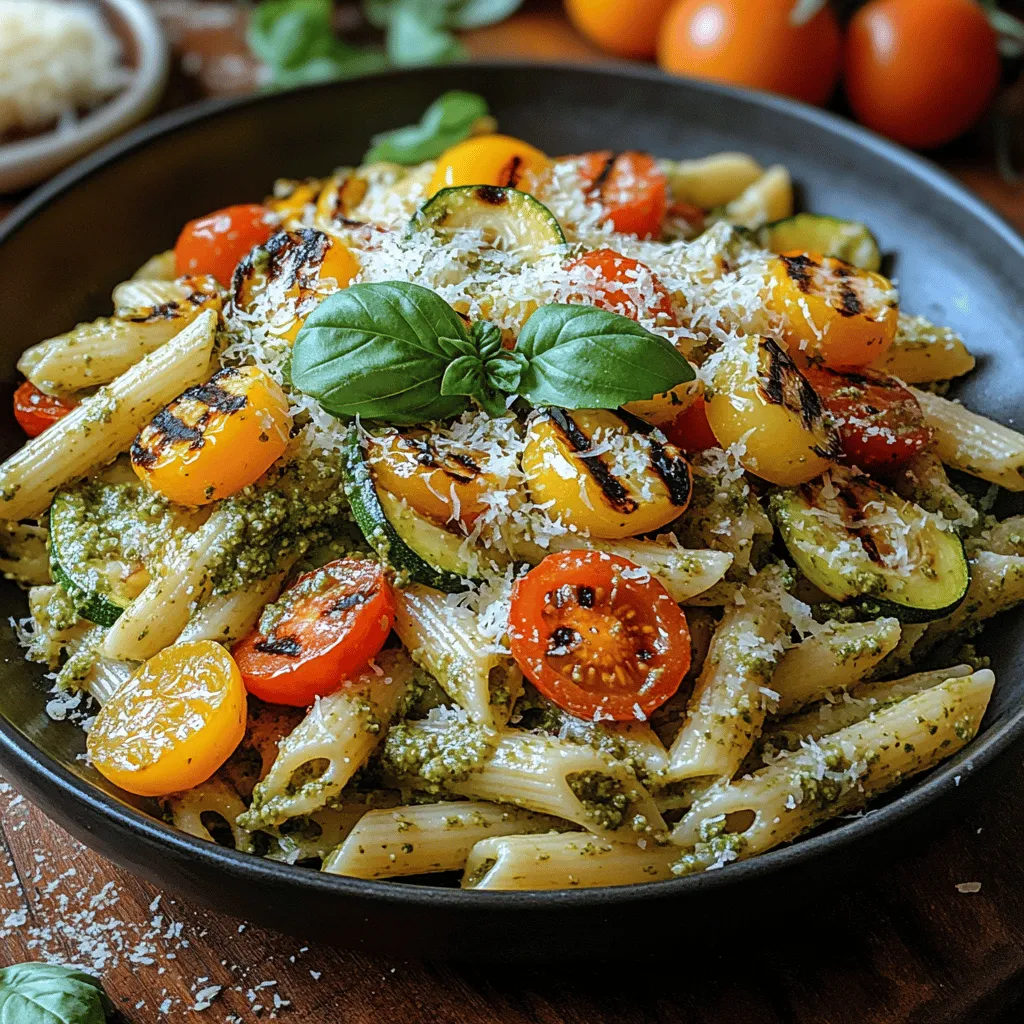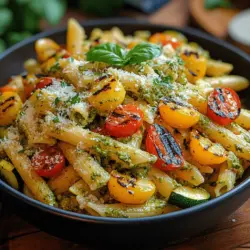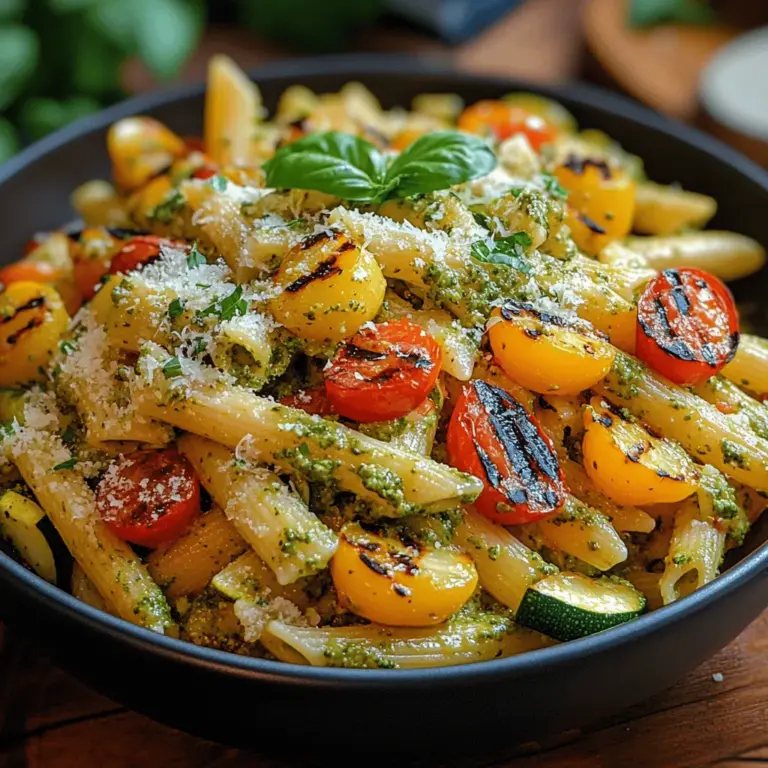Grilled Veggie Pesto Pasta: A Deliciously Vibrant Dish
When it comes to pasta dishes that are both healthy and bursting with flavor, Grilled Veggie Pesto Pasta stands out as a top contender. This colorful and delicious meal brings together the freshness of grilled vegetables, the richness of homemade pesto, and the comforting texture of pasta, making it a perfect option for any occasion. Whether you’re looking for a quick weeknight dinner or a dish to impress guests at a dinner party, Grilled Veggie Pesto Pasta has you covered.
One of the key elements that elevate this dish is the use of fresh, high-quality ingredients. Fresh vegetables not only add vibrant colors and textures but also pack a nutritional punch. Meanwhile, homemade pesto provides a depth of flavor that store-bought varieties often lack, enhancing the overall taste of the dish. By taking the time to prepare your own pesto and selecting seasonal vegetables, you ensure that every bite is a celebration of freshness.
The versatility of Grilled Veggie Pesto Pasta is another reason to love it. You can easily customize the recipe based on the vegetables you have on hand or your personal preferences. This means that whether it’s summer, when zucchini and bell peppers are at their peak, or winter, when root vegetables might be more readily available, you can adapt this dish to make it suitable for any season.
Understanding the Ingredients
At the heart of Grilled Veggie Pesto Pasta are three main components: pasta, grilled vegetables, and pesto. Each plays a vital role in creating a dish that is not only delicious but also nourishing.
Pasta serves as the foundation of the dish, providing a satisfying base that absorbs the flavorful pesto and complements the grilled veggies. When choosing pasta, it’s essential to consider not only the flavor but also the nutritional value. Whole grain or legume-based pastas offer increased fiber and protein content, making them healthier alternatives to traditional refined pasta.
Grilled vegetables are the stars of this dish. Grilling not only enhances their natural sweetness through caramelization but also adds a smoky flavor that pairs beautifully with the pesto. The combination of fresh veggies not only makes the dish visually appealing but also boosts its nutritional profile, offering a variety of vitamins, minerals, and antioxidants.
Pesto, the final key ingredient, is a traditional Italian sauce made primarily from fresh basil, garlic, pine nuts, Parmesan cheese, and olive oil. When made from scratch, pesto can be tailored to suit your taste preferences and dietary needs. Fresh basil provides a fragrant aroma and vibrant green color, while the nuts and cheese add richness and depth. Homemade pesto is far superior to store-bought varieties in flavor and freshness, making it worth the effort.
Choosing the Right Pasta
When it comes to selecting the right type of pasta for Grilled Veggie Pesto Pasta, the choice can significantly affect the overall texture and enjoyment of the dish. Two popular options are penne and farfalle, each offering unique characteristics.
Penne is a tubular pasta that holds onto sauces exceptionally well, making it a popular choice for dishes where you want every bite to be coated in flavor. Its ridges and hollow shape are perfect for capturing bits of grilled vegetables and pesto, ensuring a well-distributed taste in every forkful.
Farfalle, also known as bow-tie pasta, presents a slightly different texture. Its unique shape adds an element of fun to the dish and can create a delightful contrast against the smoothness of the pesto. The flat surfaces of farfalle also provide ample area for the sauce to cling to, ensuring a flavorful experience with each bite.
Regardless of the type of pasta you choose, achieving the perfect al dente texture is crucial. Start by bringing a large pot of water to a rolling boil, and don’t forget to generously season the water with salt. This step is vital as it enhances the flavor of the pasta itself. Follow the cooking instructions on the pasta package but keep in mind that you’ll want to taste it a minute or two before the suggested cooking time is up to ensure it retains a slight firmness.
For those seeking gluten-free or whole grain options, many brands now offer excellent alternatives made from rice, quinoa, or chickpeas. These options provide a nutritious twist without sacrificing flavor or texture, making them perfect substitutes in this vibrant pasta dish.
Grilled Veggies: The Heart of the Dish
Grilling vegetables is not just about cooking; it’s about enhancing flavors through caramelization and achieving the perfect char. The grilling process transforms the natural sugars in the vegetables, resulting in a depth of flavor that is hard to replicate through other cooking methods. For Grilled Veggie Pesto Pasta, you’ll want to select a colorful array of vegetables to create a stunning presentation and a variety of flavors.
Zucchini is a fantastic choice for grilling; its mild flavor and high water content make it tender and juicy. When grilled, zucchini develops a delightful char that complements the basil pesto beautifully.
Bell peppers, available in a range of colors from red to yellow to green, provide sweetness and a crunchy texture. Their natural sugars caramelize when grilled, enhancing their flavor profile and adding a colorful contrast to the dish.
Cherry tomatoes are another superb addition to grilled vegetables. When exposed to heat, they burst with juiciness, offering a sweet and tangy flavor that brightens the entire pasta dish. Their vibrant color also contributes to the visual appeal.
Red onion adds a sharpness that balances the sweetness of the other vegetables. When grilled, red onions become tender and milder in flavor, providing depth to the overall dish.
To prepare your vegetables for grilling, start by washing and slicing them into even pieces to ensure uniform cooking. A good rule of thumb is to cut the vegetables into sizes that will cook at the same rate. For example, slice zucchini into thick rounds, quarter the bell peppers, and halve the cherry tomatoes. Toss the vegetables in a bit of olive oil, salt, and pepper to enhance their natural flavors.
Once your grill is preheated, place the vegetables directly on the grates or use a grill basket for smaller pieces. The goal is to achieve a nice char without overcooking, which can lead to mushiness. Depending on the vegetable, grilling times will vary—typically, zucchini and bell peppers take about 4-5 minutes per side, while cherry tomatoes will need only a few minutes until they begin to blister.
By carefully selecting and grilling your vegetables, you set the stage for a delightful pasta dish that is not only visually stunning but also packed with flavor and nutrients. As you embark on this culinary journey, the next step is crafting the perfect pesto to tie everything together.

Understanding Pesto and Its Origins
Pesto is a classic Italian sauce that hails from the Liguria region, specifically from the city of Genoa. Traditionally, pesto is created by blending fresh basil leaves, garlic, pine nuts, Parmesan cheese, and olive oil, resulting in a vibrant green sauce that is rich in flavor and aromatic qualities. The name “pesto” comes from the Italian word “pestare,” which means to pound or crush, reflecting the original method of preparation using a mortar and pestle. This sauce not only enhances the taste of pasta dishes but also serves as a delightful dressing for salads, sandwiches, and grilled meats.
Ingredients Breakdown for Pesto
To create a delicious homemade pesto for your Grilled Veggie Pesto Pasta, you will need the following ingredients:
1. Fresh Basil: The star of the show, basil brings a fragrant, peppery flavor that is essential for authentic pesto. Choose vibrant, green leaves without any blemishes.
2. Pine Nuts (or Walnuts): Pine nuts are traditional for pesto, imparting a buttery richness. If you prefer a more budget-friendly option or want a different flavor profile, walnuts work wonderfully as a substitute.
3. Parmesan Cheese: Freshly grated Parmesan adds a salty, nutty depth to the sauce. Always opt for high-quality cheese for the best taste.
4. Garlic: Fresh garlic gives the pesto a robust kick. Adjust the amount based on your preference for garlic intensity.
5. Olive Oil: Extra virgin olive oil is ideal for its fruity flavor and health benefits. It helps to emulsify the ingredients into a creamy sauce.
6. Lemon Juice: A splash of fresh lemon juice brightens the flavors and prevents the basil from browning, giving your pesto a fresh taste.
Step-by-Step Instructions for Making Pesto
Making pesto at home is straightforward, especially with a food processor. Follow these steps for perfect results:
1. Prepare Ingredients: Gather all your ingredients. Rinse the fresh basil leaves under cold water and pat them dry with a paper towel. If using pine nuts, lightly toast them in a skillet over medium heat for 3-5 minutes until fragrant, but be careful not to burn them.
2. Blend the Basil and Nuts: In your food processor, add the fresh basil leaves and pine nuts (or walnuts). Pulse several times until coarsely chopped.
3. Add Garlic and Cheese: Add the garlic cloves and grated Parmesan cheese to the mixture. Pulse again until everything is finely chopped and well combined.
4. Incorporate Olive Oil: While the food processor is running, slowly drizzle in the olive oil until the mixture is smooth and creamy. You may need to scrape down the sides of the bowl to ensure everything is blended evenly.
5. Season and Adjust: Add the lemon juice, and season with salt and pepper to taste. If the pesto is too thick, you can add more olive oil or a splash of water to reach your desired consistency.
6. Taste and Modify: The beauty of pesto is that it is highly customizable. Taste your pesto and adjust the flavors as needed, whether that means adding more garlic, cheese, or lemon juice.
Combining the Elements
Now that you have your delightful homemade pesto ready, it’s time to combine it with the grilled veggies and pasta.
1. Cook the Pasta: Begin by cooking your choice of pasta according to the package instructions until al dente. Reserve about half a cup of pasta water before draining.
2. Grill Your Vegetables: While the pasta cooks, grill your chosen vegetables. Bell peppers, zucchini, and asparagus work beautifully. Toss them in olive oil, salt, and pepper, then grill until they are tender and have nice char marks.
3. Combine Pasta and Veggies: In a large mixing bowl, combine the drained pasta with the grilled vegetables. Add the prepared pesto and mix well, ensuring the pasta and veggies are evenly coated.
4. Adjust Consistency: If the pasta seems dry, gradually add reserved pasta water until you reach the desired consistency. The sauce should cling beautifully to the pasta.
Tips for Achieving the Right Consistency and Flavor Balance
– Taste as You Go: Always taste your dish at various stages. Adjust seasoning and flavors as needed, ensuring a harmonious blend of ingredients.
– Pasta Water Magic: The starchy pasta water is a secret weapon. It helps to emulsify the sauce, creating a perfect creamy texture without making it greasy.
– Don’t Overlook the Veggies: The grilled vegetables should have a slight crunch to them, as they will add texture and flavor to the dish. Avoid overcooking them.
Serving Suggestions and Pairings
Once your Grilled Veggie Pesto Pasta is beautifully combined, it’s time to serve. Here are some ideas for serving and enhancing your meal:
– Warm vs. Room Temperature: This dish can be enjoyed warm or at room temperature. If serving at a gathering, it can be prepped ahead and served at room temperature for convenience.
– Garnishing Options: Top your pasta with freshly grated Parmesan cheese and a handful of torn basil leaves for a visually appealing and flavorful finish.
– Sides and Accompaniments: Pair your pasta with a side of garlic bread or a crisp green salad. A simple vinaigrette can provide a refreshing contrast to the richness of the pesto.
– Wine Pairings: For an elevated dining experience, consider serving a glass of Sauvignon Blanc or a light Pinot Grigio. These wines complement the vibrant flavors of the pesto and the grilled vegetables perfectly.
The Versatility of Grilled Veggie Pesto Pasta
One of the best aspects of Grilled Veggie Pesto Pasta is its versatility. Here are some ideas to customize your dish:
– Protein Additions: For a heartier meal, consider adding grilled chicken, shrimp, or crispy tofu. These options not only enhance the dish’s protein content but also introduce new flavors.
– Seasonal Vegetables: Feel free to swap out vegetables based on what’s in season. Seasonal produce can elevate your dish, providing freshness and variety.
– Meal Prep and Storage: This pasta dish stores well in the refrigerator for up to three days. To reheat, add a splash of olive oil or pasta water to restore moisture.
– Dietary Adaptations: For a vegan version, simply omit the Parmesan cheese or substitute it with a dairy-free alternative. You can also add nutritional yeast for a cheesy flavor without the dairy.
Conclusion
Grilled Veggie Pesto Pasta is a celebration of fresh ingredients and bold flavors. With its vibrant colors and delightful textures, this dish is sure to impress at any dinner table. Whether you enjoy it warm or at room temperature, the combination of grilled veggies and homemade pesto creates a satisfying meal that is both nutritious and delicious.
We encourage you to experiment with the recipe, personalize it to suit your tastes, and explore the joys of cooking with fresh ingredients. The satisfaction of preparing a homemade meal, bursting with flavor and creativity, is a rewarding experience that everyone should embrace. So grab your ingredients and start creating your own version of this delightful dish!


